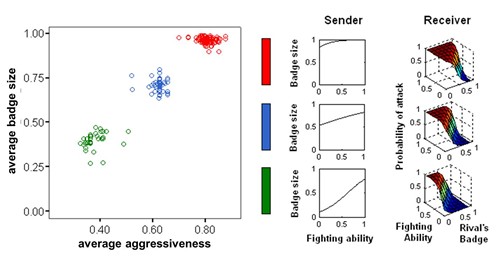The evolution of communication strategies
Unexpectedly, individual variation also plays a central role in a different project, where we modelled the evolution of communication strategies. Communication is a process in which senders provide information via signals and receivers respond accordingly. The evolution of signalling has already been modelled repeatedly, but implicitly all these models assume a priori that the evolving signals have a ‘meaning’ for their receiver. In contrast, we developed a model where a signalling strategy (a ‘sender code’ determining what kind of signal is to be sent given the sender’s state) co-evolves with a response strategy (a ‘receiver code’ determining the response of the receiver to different types of signal). In our model, sender and receiver codes are represented by evolvable norms of reaction.
Our model (Botero et al., Evolution, 2010) is based on a situation where individuals signal their 'quality' (more specifically, their fighting ability) in agonistic interactions with rivals. Each individual is repeatedly confronted with rivals and must repeatedly choose whether to attack or not. Individuals differ in quality and in case of escalation the opponent of higher quality has a higher probability of winning the fight. In a situation like this, signalling quality may be profitable because it can help avoid costly escalation. This will only happen if (1) senders do not ‘cheat’, that is, if signal intensity shows a clear-cut relationship with individual quality; and if (2) receivers respond adequately by avoided escalated fights with individuals signalling high quality. When talking about signals, we imagine the badges of status of birds. Accordingly, we use the terms 'signal intensity' and 'badge size' interchangeably.
In our individual-based simulations, communication strategies always converged rapidly to equilibrium. As expected from costly signalling theory, the average sender code evolves into a norm of reaction where individuals of higher quality produce larger badges. The average receiver code at equilibrium is a norm of reaction where the probability of attack increases with own quality but decreases with the size of the opponent’s badge. Surprisingly, however, the average norms of reaction are not representative for individual behaviour. Upon inspection of the individual distribution of traits in the evolved populations, we discovered that individual behaviours were strikingly different from the average population codes. To explore the nature of this variation we summarized each sender code with the average badge size produced by this code and each receiver code with its average probability of attack. Figure 1 (left panel) depicts these summary statistics for each of the 3,000 individuals at the end of a representative simulation run. The figure reveals that there are three distinct co-existing strategies in the population that are represented to the right in Figure 1. One class of individuals (green) develops relatively small badges and is readily 'intimidated' by opponents with large badges. A second class of individuals (red) develops large badges irrespective of underlying quality and is highly aggressive irrespective of the signals received from opponents. A third class of individuals (blue) is of an intermediate type.

A closer analysis of the model suggests that alternative communication strategies (alternative 'dialects' of a common language) will evolve whenever senders possess imperfect information about their own quality or state. These findings provide an explanation for recent reports of individual differences in communication strategies. They also shed some new light on the evolutionary stability of 'cheating': while reliable information about the signallers' quality is conveyed within each type of communication strategy, misrepresentation and misinterpretation occurs across communication strategies. Last, but not least, our model provides a new kind of explanation for the coexistence of behavioural types (animal 'personalities'): if individuals differ in the production and interpretation of signals, they will also show consistent differences in behaviour.
